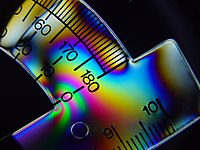
Photo from wikipedia
We conducted an experimental investigation on the flexural behavior of closed-cell aluminum foam beam under shear stress effect. Three-point bending and flexural vibration tests were carried out and the shear… Click to show full abstract
We conducted an experimental investigation on the flexural behavior of closed-cell aluminum foam beam under shear stress effect. Three-point bending and flexural vibration tests were carried out and the shear stress effect was generated by changing the specimen’s length. From the bending test, the measured deflection was used to quantify the flexural modulus. From the vibration test, the measured natural frequencies of flexural vibration mode were used to calculate the flexural modulus. The results show that the flexural moduli obtained from both tests agree well. Then, the flexural modulus value was compared with the theoretical value estimated by Timoshenko’s beam theory. As a result, the experimental value was found to be much smaller than the theoretical value when shear stress effect is dominant. Does this mean Timoshenko’s theory cannot describe the flexural behavior of aluminum foam beam? How to fit Timoshenko’s theory with the experimental data is discussed. Moreover, the reason why the flexural modulus was remarkably degraded under shear effect is elaborated.
Journal Title: Journal of Mechanical Science and Technology
Year Published: 2020
Link to full text (if available)
Share on Social Media: Sign Up to like & get
recommendations!